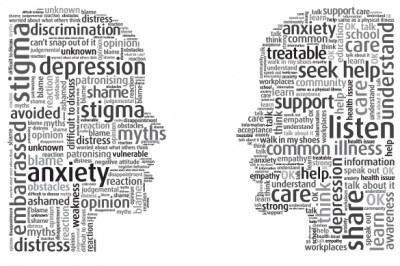Depression is the fifth leading cause of the global burden of disease and first leading mental health cause (Vos et al., 2017). Whilst everyone experiences sadness and perhaps even depression at times in their lives, perhaps following loss of a loved one, those with clinical depression experience symptoms that go on for longer, are more severe, and/or interfere with the activities that make up normal daily life.
A persistent low mood is one of the two core symptoms of depression; the other is a loss of interest or pleasure in previously enjoyable activities.
There are different types of depressive disorders, with eight diagnoses in the current Diagnostic and Statistical Manual (DSM-V; American Psychiatric Association, 2013), including major depressive disorder and persistent depressive disorder (dysthymia). Depressive disorders are distinct from bipolar disorder where the patient also experiences episode(s) of mania. When people talk about clinical depression they are usually referring to major depressive disorder, which is the most prevalent (Fassassi et al., 2014). A diagnosis requires one or both of the two core symptoms (persistent low mood and loss of pleasure/interest), as well as other symptoms which are much less often discussed or represented in portrayals of depression, but which have profound impact on daily functioning and well-being. For example, some individuals experience significant weight loss or gain due to a disrupted appetite, find themselves unable to sleep (insomnia) or sleep excessively (hypersomnia). Additional symptoms may be feelings of guilt, low self-esteem or irritability, as well as suicidal thoughts. Given this range of symptoms, it is possible for two people with a depression diagnosis to present very differently. There can also be differences in terms of how long the symptoms go on for, and how severe they are. Depression is usually experienced in episodes, with periods of remission (where the individual experiences much lower levels of symptoms) in between. Some people have just one episode in their life, but many suffer from recurrent episodes. For others their depression might be persistent without periods of remission.
Prevalence and Age of Onset
Globally, depressive disorders affect approximately 13% of individuals across their lifetime (Kessler & Bromet, 2013). However, prevalence varies across cultures, with one study reporting prevalence rates ranging from 3% in Japan to 16.9% in the United States. Women are at approximately twice the risk of depression compared to men and this is observed across cultures (Andrade et al., 2003). Interestingly, this sex difference does not emerge until adolescence (Hankin et al., 1998).
The onset of depression is on average (median) early- to mid-twenties. However, this is highly variable, with child, adolescent and older age depression also reported (Kessler & Bromet, 2013; Costello et al., 2003).
Whilst recognizing that depression is relatively common could help to reduce stigma, it should not minimize the perceived severity of this disorder. Depression is implicated in around 2 million deaths a year through suicide and increased risk of diseases such as cardiovascular disease (Patel et al., 2016).
Heritability
The heritability of a trait or disorder is an estimate of the extent to which individual differences in the population are explained by genetic differences between people (there will be more details about heritability in our letter H post). Twin studies estimate the heritability of depressive disorders at approximately 40% (Sullivan, Neale, & Kendler, 2000). Progress in understanding the specific genes involved in depression has been somewhat slow, but a recent genome-wide study by the Psychiatric Genomics Consortium has made great strides forward, identifying 44 relevant genetic variants (Major Depressive Disorder Working Group of the PGC, 2017).
Environment
Environmental factors also contribute to the onset of depression. Stressful life events and trauma have been extensively studied, both in childhood and adulthood, in association with depression. Events such as financial problems or divorce often precede a depressive episode (Mazure, 1998), but there is a great deal of individual variation in the responses to such experiences. One factor that has been demonstrated to increase vulnerability to stressful life events in adulthood is the loss of a parent during childhood (Brown & Harris, 1978), with the risk of developing depression increasing significantly when this occurs in early childhood (Berg, Rostila, & Hjern, 2016). Furthermore, childhood trauma, such as abuse or neglect, is an especially strong risk factor for depression in later life, potentially due to the impact of these extremely stressful events on the developing central nervous system (Heim & Binder, 2012).
Available Treatments
Similar to anxiety, there are various treatments available. The National Institute for Health and Care Excellence (NICE) recommends psychological (talking) therapies and antidepressant medication, independently or in combination. The NHS Improving Access to Psychological Therapies initiative enables individuals to refer themselves for assessment and treatment online, if in an eligible area. They offer a range of evidence-based interventions, from self-help books and exercise to one-to-one sessions of cognitive behavioural therapy or counselling. As no single treatment will work for everyone, mental health researchers are striving to develop new treatments and ways to predict individual response to different types of treatment.
This storyboard about depression gives a very insightful first-hand account of what it feels like to live with depression:
https://www.buzzfeed.com/kayeblegvad/dog-years?utm_term=.suNpZwX45#.beKrPv8wq
If you have been experiencing symptoms of depression, visit your GP to discuss your options. There are also many useful services online, such as information on local peer support groups and self-help techniques, as well as confidential helplines if you want someone to talk to. We have listed some of them below.
Samaritans:
Confidential support for people experiencing distress, struggling to cope, or at risk of suicide
www.samaritans.org.uk
Phone: 116 123 (free 24-hour helpline)
Mind:
Mental health charity providing advice and support as well as raising awareness.
http://mind.org.uk/
Phone: 0300 123 3393 (local rate, Mon – Fri 9am – 6pm)
They also have a helpline providing legal information and an info-line for emergency services staff.
Big White Wall:
An online peer support community for adults experiencing distress. It is free to use via the NHS in many areas, as well as for serving personnel, veterans and some university students. www.bigwhitewall.com
NHS Self-help Leaflet:
https://web.ntw.nhs.uk/selfhelp/
Find your local IAPT service:
https://www.nhs.uk/Service-Search/Psychological-therapies-(IAPT)/LocationSearch/10008
There are also more specific services, such as PANDAS for pre- and post- natal depression (http://www.pandasfoundation.org.uk, 0843 2898401 (5p per minute, daily 9am – 8pm)) and the Muslim Youth Helpline, providing culturally-sensitive support (https://www.myh.org.uk, 0808 8082008 (free, daily 4pm – 10pm)).
References
American Psychiatric Association. (2013). Diagnostic and statistical manual of mental disorders (5th ed.). Washington: DC. https://doi.org/10.1176/appi.books.9780890425596.744053
Andrade, L., Caraveo-Anduaga, J. J., Berglund, P., Bijl, R. V., De Graaf, R., Vollebergh, W., … Wittchen, H. U. (2003). The epidemiology of major depressive episodes: Results from the International Consortium of Psychiatric Epidemiology (ICPE) Surveys. International Journal of Methods in Psychiatric Research, 12(1), 3–21. https://doi.org/10.1002/mpr.138
Berg, L., Rostila, M., & Hjern, A. (2016). Parental death during childhood and depression in young adults – a national cohort study. Journal of Child Psychology and Psychiatry and Allied Disciplines, 57(9), 1092–1098. https://doi.org/10.1111/jcpp.12560
Brown, G. W., & Harris, T. O. (1978). Social Origins of Depression: A Study of Psychiatric Disorder in Women. New York: Free Press Brunson.
Costello, E. J., Mustillo, S., Erkanli, A., Keeler, G., & Angold, A. (2003). Prevalence and development of psychiatric disorders in childhood and adolescence. Archives of General Psychiatry, 60, 837–844. https://doi.org/10.1001/archpsyc.60.8.837
Fassassi, S., Vandeleur, C., Aubry, J. M., Castelao, E., & Preisig, M. (2014). Prevalence and correlates of DSM-5 bipolar and related disorders and hyperthymic personality in the community. Journal of Affective Disorders, 167, 198–205. https://doi.org/10.1016/j.jad.2014.06.004
Hankin, B. L., Abramson, L. Y., Moffitt, T. E., Angell, K. E., Silva, P. A., & McGee, R. (1998). Development of depression from preadolescence to young adulthood: Emerging gender differences in a 10-year longitudinal study. Journal of Abnormal Psychology, 107(1), 128–140. https://doi.org/10.1037/0021-843X.107.1.128
Heim, C., & Binder, E. B. (2012). Current research trends in early life stress and depression: Review of human studies on sensitive periods, gene-environment interactions, and epigenetics. Experimental Neurology. https://doi.org/10.1016/j.expneurol.2011.10.032
Kessler, R. C., & Bromet, E. J. (2013). The Epidemiology of Depression Across Cultures. Annual Review of Public Health, 34(1), 119–138. https://doi.org/10.1146/annurev-publhealth-031912-114409
Major Depressive Disorder Working Group of the PGC. (2017). Genome-wide association analyses identify 44 risk variants and refine the genetic architecture of major depression. bioRxiv, 167577. https://doi.org/10.1101/167577
Mazure, C. M. (1998). Life stressors as risk factors in depression. Clinical Psychology: Science and Practice, 5(3), 291–313. https://doi.org/10.1111/j.1468-2850.1998.tb00151.x
Patel, V., Chisholm, D., Parikh, R., Charlson, F. J., Degenhardt, L., Dua, T., … Whiteford, H. (2016). Addressing the burden of mental, neurological, and substance use disorders: Key messages from Disease Control Priorities, 3rd edition. The Lancet. https://doi.org/10.1016/S0140-6736(15)00390-6
Sullivan, P. F., Neale, M. C., & Kendler, K. S. (2000). Genetic epidemiology of major depression: Review and meta-analysis. American Journal of Psychiatry, 157(10), 1552–1562. https://doi.org/10.1176/appi.ajp.157.10.1552
Vos, T., Abajobir, A. A., Abbafati, C., Abbas, K. M., Abate, K. H., Abd-Allah, F., … Murray, C. J. L. (2017). Global, regional, and national incidence, prevalence, and years lived with disability for 328 diseases and injuries for 195 countries, 1990-2016: A systematic analysis for the Global Burden of Disease Study 2016. The Lancet, 390(10100), 1211–1259. https://doi.org/10.1016/S0140-6736(17)32154-2




[…] For more information on Depression see our previous post on the blog: D for Depression […]